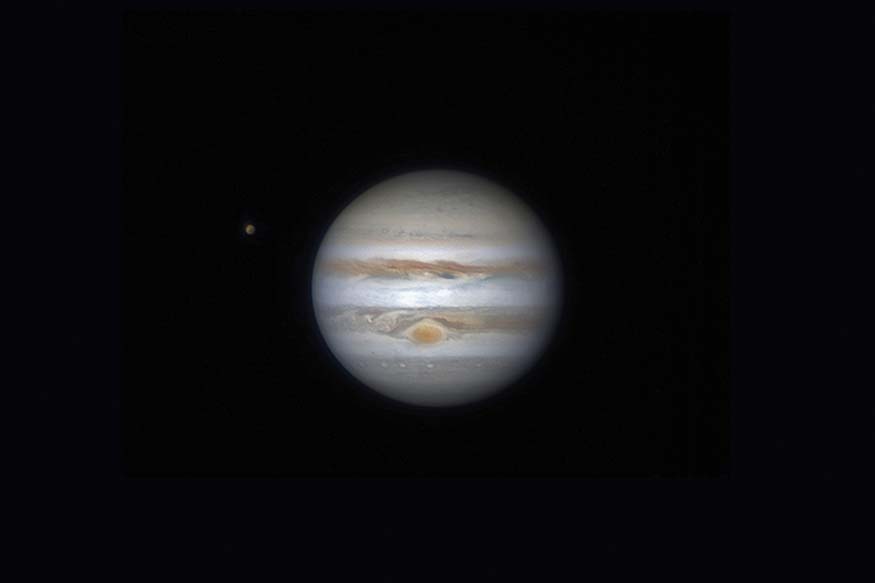
BEAUTY: 
BRAGGING RIGHTS: An amazing sight
HOW EASY IS IT TO SEE? Best with a small telescope
TYPE: Planet
DISCOVERED: Known since antiquity
Even 3,000 years ago it was obvious that Jupiter is the King of the Planets. Venus may sometimes shine brighter, but it never strays from the setting or rising sun. In contrast, Jupiter commands the sky, shining brightly throughout the night. It’s no wonder the ancient Greeks and Romans named it after their most powerful god.
Today we know that Jupiter is the largest planet in our star system. It is a massive ball of hydrogen, more than twice as heavy as all the rest of the planets combined. An alien astronomer might accurately describe the solar system as consisting of the sun, Jupiter, and assorted other debris.
Jupiter has 67 known moons, forming its own solar system in miniature. Its four largest moons are all bigger than Pluto, and its largest moon, Ganymede, is bigger than Mercury. These four satellites, called the Galilean moons, after their discoverer, Galileo Galilei, are complex and fascinating worlds on their own. Io, the innermost of these, is covered in volcanoes, which are powered by the tidal forces of massive Jupiter. Europa, a little farther out, has a global ocean beneath a layer of ice, and the planet is also kept warm by tidal heating. (It is one of the most likely candidates for life outside of Earth.) Even cold and cratered Callisto is fascinating for its tenuous atmosphere and complex geology.
WHAT YOU MIGHT SEE THROUGH AMATEUR EQUIPMENT
From Earth, Jupiter appears bright, but small. In binoculars you’ll just barely be able to see it as a disk. A telescope with moderate to high magnification will reveal more detail, including the major bands of clouds.
Jupiter is bright enough that you needn’t worry about light pollution—even city skies will offer a decent view. But you must wait for crisp and steady skies. Even a little bit of turbulence will blur your view. The best nights to see Jupiter are those cold and clear winter nights when the stars seem bright and steady. If you’re using a telescope on a cold night, wait for it to cool down; otherwise, the warm air in the tube will distort your vision, like the ripples rising over hot pavement.
Belts and zones. Through a small telescope you will instantly see two parallel dark lines straddling Jupiter’s equator. These are the two major equatorial belts. The brighter areas around the belts are known as zones. With higher magnification (and steady skies) you might be able to see other smaller belts above and below the two major ones.
The Great Red Spot. The Great Red Spot is a hurricane large enough to swallow the entire Earth about two times over. It’s been raging since at least 1665, when it was discovered by Giovanni Cassini. Despite its name, it may not look very red to you.
Jupiter rotates once every 10 hours, so the Red Spot may not always be facing you. Programs such as Starry Night can predict the position of the Red Spot on any given night. But you can also try observing at different times. If you don’t see the Red Spot, try again in two-and-a-half hours, when Jupiter will have turned 90 degrees.
Galilean Moons. The Galilean moons are easy to spot. You’ll see one or more little starlike objects on a line crossing Jupiter’s equator. The moons move back and forth along the line each night. Galileo plotted their motion from night to night and quickly realized that they orbited Jupiter. This contradicted the belief that everything orbited the Earth, and lent credence to (though it did not prove) Copernicus’s theory of a sun-centered system.
Moon Shadows. Once in a while a Galilean moon is aligned such that it casts a shadow on the face of Jupiter. You’ll see a tiny black spot on the disk, moving very slowly across it. Once again, an astronomy program is your best resource for determining when such an event will happen.
|
DATES WHEN JUPITER IS AT OPPOSITION AND WHERE TO LOOK |
|
DATE |
CONSTELLATION |
April 7, 2017 |
Virgo |
May 9, 2018 |
Libra |
June 10, 2019 |
Ophiuchus |
July 14, 2020 |
Sagittarius |
August 19, 2021 |
Aquarius |
September 26, 2022 |
Cetus |
November 3, 2023 |
Aries |
December 7, 2024 |
Taurus |
January 10, 2026 |
Gemini |
February 19, 2027 |
Leo |